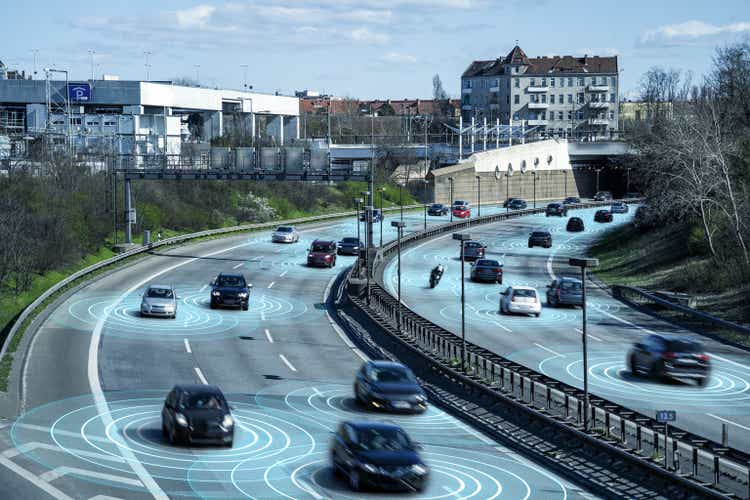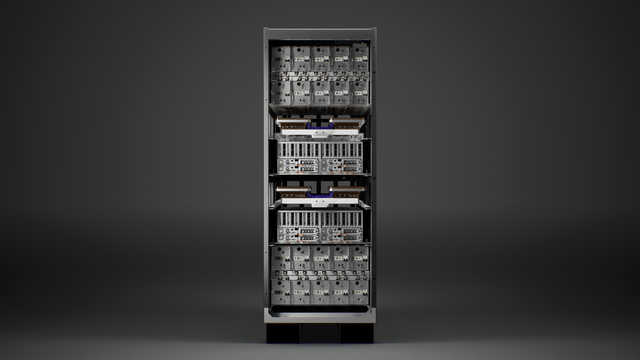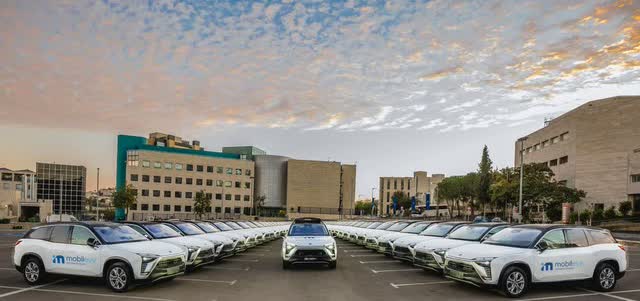Summary:
- The goal of creating a car that can drive itself as safely as a human driver is gaining feasibility after years of being considered unlikely.
- Tesla is using AI principles and its “Dojo” ultra-powerful computing system to develop a self-driving system that learns from human examples.
- Other companies, such as GM and Google, also are working on self-driving technology, but the systems are currently too expensive for wide-scale adoption.
- A Tesla breakthrough likely would result in price runup.

Self Driving Autonomous Cars on Highway
IGphotography/iStock via Getty Images
With each new announcement from Alphabet (GOOG) (GOOGL), General Motors Co. (GM) and others engaged in robotaxi pilots in San Francisco, Phoenix and elsewhere, the mobility industry takes a step closer to full self-driving tech. Will scalable full self-driving be achieved in a year, 10 years or, maybe, never? No one knows.
Importantly, however, the goal of creating a car that can drive itself as or more safely than a human driver under any and all conditions is once more gaining feasibility after several years of being considered unlikely and expectations of a breakthrough lowered due to technical hurdles.
Rethinking
A major change in thinking has taken place over the past several months, stimulated mainly by Tesla (NASDAQ:TSLA) and the surging popularity of artificial intelligence – AI – tools like ChatGPT. Elon Musk, CEO, plays a key role as well. According to a new biography of Musk by Walter Isaacson, Musk in early August of this year rode in one of his company’s car being driven by FSD12, a self-driving system based on AI principles.
FSD12 employs Tesla’s “Dojo” ultra-powerful computing system. “Instead of determining the proper path of the car based on rules,” Dhaval Shroff, a member of Tesla’s self-driving team explained to CNBC.com: “we determine the car’s proper path by relying on a neural network that learns from millions of examples of what humans have done.”

Tesla Dojo Supercomputer (Tesla)
Dojo, which went into production in July, is a supercomputer designed by Tesla for video processing and recognition to train the company’s machine learning – AI – for self-driving. Many of the video clips being fed into Dojo have been collected by Tesla vehicles that have been photographing their owners’ performance on the road. Tesla says it has invested at least $1 billion to create its own supercomputer, which relies heavily on chips manufactured by Nvidia (NVDA).
“We process an enormous amount of data on how real human drivers acted in a complex driving situation,” said Shroff, “and then we train a computer’s neural network to mimic that.”
Sure bestseller
According to the excerpt from Isaacson’s new biography, reported by CNBC, Musk in August took a Tesla Model S for a successful self-driving spin across Silicon Valley (and past the home of Facebook CEO Mark Zuckerberg) using FSD12. Though Musk had taken test drives frequently using an older technology, this time he was testing the new self-driving system based on AI, which he had ordered Tesla engineers to enable eight months previously.
One must be cautious about exciting new technologies such as self-driving, since often they are initially over-hyped with inflated expectations, followed by disillusionment and disappointment. However, once these stages have past, the technology regain promise as improvements and breakthroughs take place.
In the case of self-driving, 2010 was a pivotal year. That’s when the New York Times published a front-page story reporting that Google had been secretly testing self-driving prototypes on California roads, logging a million or so miles. The report and its vast implications for personal mobility captured the attention of global automakers and the tech world. Soon every automaker, many automotive suppliers and lots of tech companies began experimenting, building prototypes and developing related products.
Over the next several years, advanced driver assistance systems (ADAS) were introduced commercially that can safely assume many driving tasks once handled by the operator, including emergency braking, lane changing and limited hands-free steering. But comprehensive robotic control that would allow a vehicle to drive itself safely with passengers not responsible for the vehicle’s operation (or without passengers at all) has proven elusive.
Pricey sensors
GM’s Cruise subsidiary and Google’s Waymo robotaxis rely on cameras, radar and lidar sensors, plus mapping software, allowing them to operate in certain defined environments such as a city or a suburb whose terrain they know. The systems are costly and, for the time being, would be impractical and too expensive for wide-scale adoption by consumers.
Several startups are pursuing AI systems vigorously, including some aimed at the self-driving market. One such company is Haifa, Israel,-based Imagry. Founded in 2015 to provide computer vision applications, Imagry was selected by Continental AG, the German automotive supplier, to provide its technology for Continental’s autonomous driving platform. Specifically, Imagry uses AI to find open spots and park the vehicle autonomously.
Tesla, which claims its cars are the safest on the road, has come under scrutiny from consumer groups and the National Highway Traffic Safety Administration for fatal accidents by drivers using its Autopilot, a self-driving function employing eight external cameras that requires the driver to pay attention and take control of the vehicle in certain situations. Critics have accused Tesla of misleading drivers, perhaps inadvertently, to assume Autopilot doesn’t require supervision.

Mobileye self-driving cars in Israel (Mobileye)
An important player among those companies producing ADAS systems and developing a self-driving system is publicly-owned Mobileye Global Inc. (MBLY), whose shares are 88%-owned by Intel (INTC). Mobileye’s founder, Amnon Shashua, responded on Sept. 14 to Tesla and Musk by asserting that a so-called “end-to-end” neural – AI – network that can perceive and respond like – or better than – a human driver may not perform flawlessly and in any case is “overkill.”
Dan Galves, a Mobileye spokesperson said “it’s not us vs. Tesla or us saying they’re wrong. In a lot of ways, we’re rooting for them.” He points out that the company uses neural networks in different ways in its own control modules though not as a core enabler of a comprehensive system.
In coming months, Tesla is likely to reveal more test results and could decide to submit its latest self-driving system to regulators in the U.S. and abroad. Government permission to use FSD12 in commercial vehicles or in robotaxis could be a major triumph for Tesla and, along with popularization of Isaacson’ biography, likely would spark a buying spree by investors.
For some, the news of Dojo and Musk’s latest test drive is part of the hype cycle – a signal for caution. Perhaps. I believe these developments merit close monitoring by investors, not just those interested in Tesla. GM, Mobileye, Google and others could be influenced to adapt their technologies by a certifiable AI breakthrough on the self-driving front.
Analyst’s Disclosure: I/we have a beneficial long position in the shares of TSLA either through stock ownership, options, or other derivatives. I wrote this article myself, and it expresses my own opinions. I am not receiving compensation for it (other than from Seeking Alpha). I have no business relationship with any company whose stock is mentioned in this article.
Seeking Alpha’s Disclosure: Past performance is no guarantee of future results. No recommendation or advice is being given as to whether any investment is suitable for a particular investor. Any views or opinions expressed above may not reflect those of Seeking Alpha as a whole. Seeking Alpha is not a licensed securities dealer, broker or US investment adviser or investment bank. Our analysts are third party authors that include both professional investors and individual investors who may not be licensed or certified by any institute or regulatory body.
